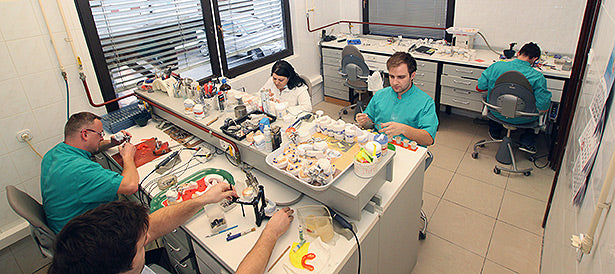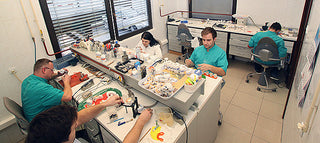
A dental laboratory, or dental lab, is a critical component of the dental care process, although it is usually behind-the-scenes. This is where dental technicians, who are trained in the practice of dental prosthetics, construct or repair dental appliances for patients, as prescribed by their dentists.
Dental laboratories create a variety of dental prosthetics including crowns, bridges, dentures, orthodontic appliances, and more. To begin the process, a dental practitioner creates a mold, or impression, of the patient's teeth. This physical or digital impression is then sent to the dental lab.
Once the lab receives the impression, dental technicians fabricate the prescribed dental appliance by mimicking the exact shape, size, and color of the patient's natural teeth. The first step typically involves creating a cast model from the impression, representing the patient's oral cavity, to which the dental appliance will fit.

If the prescribed solution is a crown or a bridge, the dental technician usually prepares a metal or porcelain restoration, ensuring it fits the cast model perfectly. If it is a denture, a careful process of shaping a wax model based on the cast, adding artificial teeth, and then creating a plastic mold from this model, is followed.
Orthodontics appliances like braces, retainers, and aligners, which are designed to move or retain the position of the teeth, are also made in dental labs. These can involve various levels of complexity in design and materials, from simple plastic or wire retainers to intricate appliance systems with springs and bands.
In addition to fabrication, dental labs also offer repair and modification services. They can mend cracks, replace missing teeth on dentures, or adjust the fit of dental appliances as per dentist’s instructions.
Complex cases may require the use of CAD (Computer-Aided Design) and CAM (Computer-Aided Manufacturing) technology. The dental technician can create a digital design of the restoration, which is then materialized using a milling machine or a 3D printer. Indeed, the advent of digital dentistry has revolutionized the work of dental labs, allowing for increased precision and faster processes.

Another key aspect of a dental lab's responsibility is to ensure all dental devices are safe, functional, aesthetically pleasing, and meet regulatory and industry standards. Depending on the country and specific regulations, dental labs may need to follow strict compliance and quality control measures.
Finally, dental laboratories also continuously collaborate with dental practitioners. Discussions about specific cases often occur to ensure the best possible outcome for the patient. This collaborative relationship allows for tailored solutions specific to each patient's unique needs.

In conclusion, a dental lab plays a pivotal role in delivering detailed, exact, and personalized dental solutions. The technicians apply a blend of artistry, science, and technology to restore and improve the oral health of countless patients.

